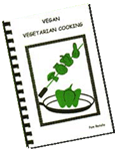
Buy your copy now!
VeggieCooking.com
Vegan Cookbook
Vegan Recipes
Vegetarian Recipes
Donate!
Suggested Reading:
Featured Articles:
My Vegetarian Cookbook Index
Healthy Eating
The Genetic Fad - A Medical Myth
Joel Wallach - Copper Deficiencies
Lawrence Broxmeyer - Mad Cow
Organophosphates - Mad Cow
Multiple Sclerosis and Mercury
Alternative Medicine Used for Flus
Good Fats (Omega-3 Fatty Acids)
Dr. Hulda Clark - Cancer and AIDs
Alternative Cancer Treatments
Vegans and Vitamin B-12
Aspartame, MSG - Excitotoxins
Sickle Cell Anemia
Jake Beason - Raising Children
Election Fraud 2004
9-11: A Government Operation
Pam Remembers Ronald Reagan
Family Values
Giving Thanks
Travel Page
Photo Gallery Main Page
The Peace (Flower) Gallery
Glacier National Park Gallery
Autumn Foliage Gallery
2004 New York City Protests
Yellowstone National Park Gallery
The Badlands Photo Gallery
Luray Caverns in Virginia
Shenandoah Caverns in Virginia
Skyline Caverns in Virginia
Endless Caverns in Virginia
Dixie Caverns in Virginia
Natural Bridge in Virginia
Crystal Caverns at Hupp Hill in Virginia
Cave of the Mounds in Wisconsin
Kickapoo Indian Caverns in Wisconsin
Crystal Cave in Wisconsin
Niagara Cave in Minnesota
Mena Airport Photo Gallery
Skyline Drive Photo Gallery
The House on the Rock Gallery
Wisconsin Windmill Farm
Copyright Notice & Limited Use
Other Health Web Sites:
Mercury Poisoned .com
Cancer Tutor .com
Dorway.com - Aspartame
Breast Implant Dangers
Dr. Hulda Clark - products
Dr. Clark Information Center
Dr. Joel Wallach
Dr. Lawrence Broxmeyer
Mark Purdey
Dr. Joseph Mercola
Dr. Hal Huggins
Dr. Lorainne Day
Dr. Andrew Weil
Dr. Ralph Moss - Cancer Decisions
Dr. Patrick Flanagan - Neurophone
NUCCA-Certified Chiropractors
Pranic Healing
Alternative News Sites:
Rense.com
What Really Happened .com
Buzz Flash .com
Information Clearing House
Prison Planet.com
Alternative Radio:
WBAI - New York City
KPFK - Los Angeles
KPFA - Berkeley
WPFW - Washington, DC
Air America Radio
MadCow.PamRotella.com
Disclaimer: This information is for educational purposes only,
and does not replace individualized diagnosis and care.
Mark Purdey's Organophosphate Model of Mad Cow Disease
 [Posted 3 January 2003, last updated November 2004]
[Posted 3 January 2003, last updated November 2004]
Among mainstream science, the current model of Mad Cow Disease (Bovine Spongiform Encephalopathy or BSE) involves "prions" -- protein rods allegedly without any DNA of their own, and an ability to survive most antiseptics and heat while remaining infectious. Mad Cow Disease is found in a number of other animals, and is called:
Mad Cow Disease (BSE - Bovine Spongiform Encephalopathy) in cattle,
CJD (Creutzfeldt-Jakob disease) in humans,
Scrapie in sheep, and
CWD (Chroinc Wasting Disease) in deer and elk.
In 2002-03, CWD was a hot news topic. Deer and elk in the area of Mount Horeb, Wisconsin, were eradicated in a brutal and controversial government-sponsored shooting spree. The mass kill-off was allegedly designed to stop the spread of CWD to other herds, but was widely attacked as a public relations ploy, useful for little else than trying to convince hunters in Wisconsin that the wild meat supply was safe and covering up the true causes of the disease.
The infectious "prion" model of these diseases claims that prions found in diseased animals are then transmitted to other animals through rendered animal products in their feed. The prions in animal feed then go on to infect many animals who consume that feed. At least that's the official line in the U.S. and Great Britain. However, at the height of the Mad Cow epidemic in England, an organic farmer's personal observations led him to a different conclusion.
Mark Purdey and the Organophosphate model of Mad Cow Disease
Somerset farmer Mark Purdey observed that the UK's Mad Cow outbreak immediately followed the government's attempt to eradicate the parasite warble fly from cattle. Most farmers were required to treat their cows' spines and skulls with Phosmet, an organophosphate pesticide. Because Purdey was an organic farmer, he obtained special permission to avoid treating his cattle. He then observed that his neighbors' treated herds went on to contract Mad Cow Disease (BSE), whereas Purdey's untreated herds did not. Purdey also had purchased a non-organic herd which had been treated with Phosmet before he acquired it. That particular herd also went on to develop Mad Cow Disease.
"Cambridge University prion biochemist, David R. Brown is dismissive of the science behind the infectious model of BSE. He terms it 'a very limited amount of science by a few assumed-reputable scientists.' He insists there is 'no evidence an infectious agent is present in either meat or milk.' " (Fintan Dunne, "Organophosphates Implicated In Mad Cow Disease")
Unfortunately, Purdey was unable to interest Britain's government or scientific community in this theory, so he proceeded to study the problem himself. Using his own money and some donations by private indivduals, Purdey funded private research and came up with the following theory:
1.) Prions are naturally-occurring proteins, involved in protecting tissues (such as the eyes) from harmful UV radiation.
2.) When exposed to both organophosphates and manganese, prions change from copper-tipped to manganese-tipped, and cause a chain reaction of prions switching to manganese "tips". (The organophosphate may serve as a chelating agent or catalyst.) Manganese-tipped prions are virtually indestructible, surviving disinfectants, autoclaves, and incineration.
3.) These chain reactions cause periods of high oxidation which burn through tissues, as evidenced by the sponge-like brains found in Bovine Spongiform Encephalopathy. (Spongiform is pronounced "SPONGE-i-form", because the brain will eventually resemble a sponge from so many holes.) Sometimes consuming the flesh, eggs, or milk of an infected animal can cause the disease, especially if the animal was consumed when a prion chain reaction was occurring. However, prion diseases are much less likely to be contracted from infected animal products than from organophosphate exposure coupled with available manganese.
4.) High-manganese, low-copper environments can create prion diseases without the organophosphate catalyst, as seen in deer and elk herds in Colorado who eat manganese-rich pine needles.
 Purdey's theory is corroborated by field data and lab tests funded with his limited resources. However, all such data is completely ignored by the UK and US governments, largely because politicians receive sizable campaign contributions from both GMO and organophosphate producers. Liability of organophosphate producers would be astronomical if Purdey's theory were accepted as the true cause of prion diseases.
Purdey's theory is corroborated by field data and lab tests funded with his limited resources. However, all such data is completely ignored by the UK and US governments, largely because politicians receive sizable campaign contributions from both GMO and organophosphate producers. Liability of organophosphate producers would be astronomical if Purdey's theory were accepted as the true cause of prion diseases.
In the case of Wisconsin, Purdey's soil samples showed a natural high-manganese, low-copper content in the CWD/Mount Horeb area. Further evidence of high manganese soil can be seen underground a few miles from Mount Horeb, in Blue Mounds, Wisconsin. Cave of the Mounds has a number of purple and black formations which they'll tell you are colored by manganese leached from the soil above. In contrast, Kickapoo Indian Caverns in Western Wisconsin has no CWD in the area, and the cave has patches of blue-green copper-rich areas on its walls, indicating the copper-rich soil above.
If Purdey's theory is correct, organophosphate pesticides and herbicides are of particular interest to vegetarians. This would put vegetarians at risk for contracting a prion disease from foods treated with organophosphate pesticides and/or herbicides. Of particular interest are soy products, specifically Roundup-Ready soybeans.
Roundup-ready soy is a GMO (genetically modified organism, a/k/a "Franken-food") specifically developed to tolerate higher levels of Roundup herbicide. Farmers who grow Roundup-ready soy are required by contract to use Roundup herbicide on their soy fields. Roundup is in the glyphosate class of herbicides, a type of organophosphate. I drove to Mount Horeb, a small town only two hours away from my mother's home in Wisconsin, and asked some of the locals if soy is grown in the area. The answer was yes, but I really didn't have to ask -- I could see the soy fields myself. How much of that soy is Roundup-ready? I haven't been able to obtain this information specifically on Mount Horeb, but there is plenty of information verifying that Roundup-ready soy is commonly grown on Wisconsin farms.
"A lobby group that includes Bayer, Monsanto, Novartis, Pfizer, Roche and Schering-Plough was behind the effort to discredit Purdey... Purdey has been consistently denied even exploratory funding to extend his privately supported research. Yet the Purdey/Brown chemical poisoning model matches with the epidemiological spread of CJD clusters in humans. It also predicts the incidence of BSE-type diseases in animals. The accepted infectious model fits neither." (Fintan Dunne, "Insecticide Causes Mad Cow Disease")
It's obvious that deer and elk in the Mount Horeb area are eating from local soy fields. If any of that soy is Roundup-ready, the high-manganese soil would provide the requisite manganese to produce CWD. And unlike humans, deer and elk don't remove soybeans from their pods or rinse them off prior to eating. In other words, they're getting the full dose of Roundup, a type of organophosphate. This would explain an outbreak of CWD in the soy-growing area of Mount Horeb.
Dr. Lawrence Broxmeyer, an expert in the class of TB bacteria, claims that Bovine tuberculosis may be the actual culprit behind Britain's Mad Cow outbreak. However, when asked about the organophosphate model, he admitted that organophosphates are one of several chemical agents which could have made the cattle more susceptible to the disease.
Avoiding organophosphates
Prion diseases are considered to be fatal in all animals. They vary in which part of the nervous system is attacked, and how long the organism will be able to survive after infection. Often the human form of prion disease, CJD, is misdiagnosed as Alzheimer's Disease, Dementia, MS, or other nervous disorders.
Steps can be taken to avoid CJD. To ensure that soy is NOT treated with Roundup, use only CERTIFIED ORGANIC soy and soy products. Soybeans treated with organophosphates, or GMO soybeans, cannot be certified as organic. Also, all animal products should be avoided, as the infectious nature of the disease is occasionally manifested (as with hunters infected from eating diseased prey). According to Purdey, the disease is infectious when prions are causing active chain reactions, but there is no way to visibly ascertain whether prion chain reactions were occurring when the animal was slaughtered.
"I shudder further when I see the bottles of OP head lice shampoo and OP systemics for pets and gardens still in the shops for human use." (Mark Purdey, "Myths &Truths About Mad Cow Disease")
Another source of organophosphates are lice, flea, and tick shampoos. This includes lice shampoos distributed by public schools. Read the label of any such product provided to your child or purchased, and check its active ingredients with your pharmacist. An internet search can also help -- in a good search engine like Google.com, type the word "organophosphate", followed by a space and then the active ingredient. Seeking natural remedies, such as neem and turmeric (see "The Green Pharmacy" by James Duke, Ph.D.), are a good way of circumventing possible organophosphates.
Finally, if farming or gardening, avoid organophosphate pesticides and herbicides. Research the products you use, then find alternatives or switch to organic farming/gardening methods. Farm workers who can't influence their employers could look into wearing protective gear, or even finding a job with a better employer.
More information
The following links provide information on the history of Purdey's research, the science linking prion diseases with organophosphates, and the difficulty Purdey and others have encountered while trying to inform the public of this horrendous connection:
http://www.mercola.com/2000/dec/17/bovine_spongiform_disease.htm
http://www.mercola.com/2000/dec/17/mad_cow_pesticides.htm
http://www.cqs.com/opmadcow.htm
http://www.nzhealth.net.nz/dis_ease/cjd.html
http://www.cultureshop.org/details.php?code=PURDEY
http://www.markpurdey.com/
http://www.purdeyenvironment.com/
Other health and nutrition articles from pamrotella.com
Today's medical fad: The Genetic Myth
Essential Fatty Acids, the "healthy fats" we all need
Copper: What aneurysms, white hair, and wrinkles have in common
Dr. Lawrence Broxmeyer's BACTERIAL Mad Cow Disease theory
Multiple Sclerosis: The mercury/parasites model
Alternative medicine vs. the common cold and flu
Hulda Clark: A cure for cancer and AIDS?
Vegans and the B-12 deficiency myth
Aspartame, MSG, and other excitotoxins
Sickle Cell Anemia: Dr. Agbai and B-12 deficiency
Jake Beason on children and boredom
Back to the top
© 2003 by Pam Rotella.
Back to Pam's vegan vegetarian FUN page
Pam's vegan vegetarian cookbook, with vegan vegetarian recipes
